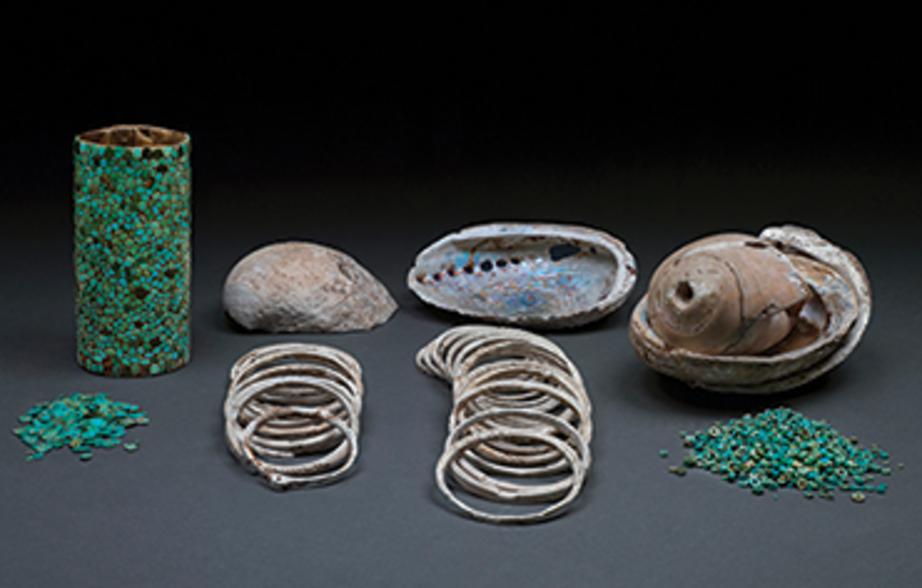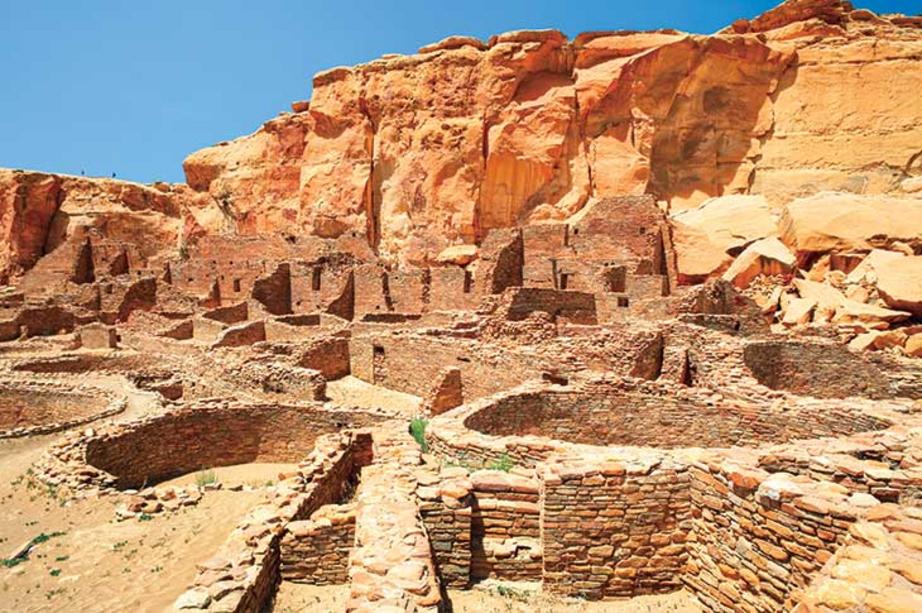Chaco Canyon’s ancient civilization continues to puzzle
A rash of studies try to piece together an early American society.
Chaco Canyon is a land of extremes. Summer heat scorches the desert canyon, which is sandwiched between sandstone cliffs nearly two kilometers above sea level in New Mexico’s northwestern corner. Bitter cold sweeps in for winter. Temperatures can swing as many as 28 degrees Celsius during the course of a day. Through it all, Chaco Canyon maintains a desolate beauty and a craggy pride as home to one of ancient America’s most enigmatic civilizations.
Scientists have struggled to understand Chaco society since its first excavations in the late 1800s. Who first settled Chaco Canyon around 1,200 years ago is still a mystery. Many researchers suspect that it took a few hundred years for a fledgling city-state run by an elite social class to emerge. Political and cultural ties between the ancient society and Chaco-style communities outside the canyon also perplex. Then there’s the puzzle of how people survived from about 800 to around 1300 on the rough, parched terrain.
A new generation of Chaco studies and discoveries is under way, partly thanks to a young researcher’s skeleton reassembly project. This jigsaw job required a lot of travel, but not to Chaco Canyon.
That’s because bones of people excavated at Chaco in the 1890s and 1920s were packed away in boxes and drawers at museums in New York City, Chicago and Washington, D.C. Kerriann Marden visited all of these places to retrieve far-flung body parts from one site in particular — Pueblo Bonito, the oldest and largest of a dozen huge stone great houses in Chaco Canyon. The structure was built, along with a range of smaller structures, between about 800 and 1130.

Finds in a burial at the first and largest great house in Chaco Canyon, Pueblo Bonito, include turquoise jewelry and shell items placed alongside a presumably influential man interred between 800 and 850.
Pueblo Bonito was massive, rising at least five stories with around 650 rooms. It has yielded more human bones and artifacts than any other Chaco site. Research has focused on this great house presumably reserved for Chaco’s elite families; the lives of workaday folk have been largely unexplored, even in the latest studies.
During Chaco society’s heyday, other civilizations peaked elsewhere in the Americas, including the Maya in Central America. Just as present-day Maya groups trace their ancestry back to that ancient civilization, today’s Pueblo tribes, such as the Hopi and Zuni, consider Chaco people to have been their forebears. Navajo Nation also claims an ancestral tie to Chaco society.
Reassembly required
Archaeological excavations a century or more ago — at Pueblo Bonito and elsewhere — didn’t follow today’s rigorous standards for excavating and preserving remains. The work consisted of little more than mining for bones and artifacts, then carting the discoveries off to museums. As an anthropology graduate student at Tulane University in New Orleans, Marden journeyed back and forth between New York’s American Museum of Natural History, Chicago’s Field Museum and Washington’s Smithsonian National Museum of Natural History from 2005 to 2011. She painstakingly reunited long-dead Chaco individuals’ skulls with arms, legs with feet and so on. Marden is now a forensic anthropologist at Eastern New Mexico University in Portales.
As skeletons assumed their former shapes, a couple of peculiar things stood out. First, many individuals bore signs of disease, including tuberculosis and syphilis. That seemed peculiar for people who were buried in a great house typically thought to have been reserved primarily for society’s upper crust, not for the ill. Second, bodies had been manipulated in unusual ways and for unknown reasons. Comparisons of restored skeletons with field notes and photographs from original excavations indicated, for instance, that one woman was originally found with a fetus’s fragile remains in her pelvic cavity and her own bones below the knees missing. Her body lay across a room from several intact bodies.
“Nothing is simple at Pueblo Bonito,” Marden says. Her campaign to put Pueblo Bonito skeletons back together has enabled a couple of provocative new investigations. One concludes that members of a single maternal line wielded power in Chaco society from the start through an unexpected stretch of at least 330 years and perhaps 10 generations. Another study proposes that Chaco society’s founders were not outsiders with experience constructing huge buildings, as many researchers have assumed. People living in and near Chaco Canyon may have established a cliff-bordered society all on their own.
Having six toes brought social honor in Chaco society.
— Patricia Crown
Other new findings suggest that Chaco residents contacted and traded with people living as far as 2,500 kilometers to the south in Central America and as close as 75 kilometers to the west and south. It’s debatable, though, whether Chaco Canyon’s 2,000 to 3,000 residents could raise enough crops to feed themselves or whether they had to trade for staples such as maize.
Less contentious — but far weirder — is evidence from graves and artwork that Chaco people revered community members with six toes and often created images of human feet and footprints with and without extra digits.
DNA dynasty
Fittingly, Chaco society’s archaeological footprint covers what was once an extensive regional system of buildings and roads. The largest great houses were clustered in a 2-kilometer-diameter downtown zone at the center of Chaco Canyon. Smaller great houses, ritual structures called kivas, groups of small family houses and other urban features, connected by a network of straight dirt roads, fanned out from the canyon across an area the size of Ireland.
After Chaco society dissolved around 1300, Pueblo groups may have rejected its centralized political system and social classes, says archaeologist Stephen Lekson of the University of Colorado Boulder. Pueblo people today live in small communities oriented around clans based on maternal lines of descent.
Therein lies a connection between past and present, says archaeologist Stephen Plog of the University of Virginia in Charlottesville. Many individuals buried in one of Pueblo Bonito’s oldest rooms, known to researchers as Room 33, shared maternal ancestry (SN Online: 2/21/17). Plog and colleagues — led by Penn State archaeologist Douglas Kennett — extracted mitochondrial DNA, which is typically passed from mother to child, from skeletons of nine of 14 individuals interred in Room 33. Marden’s reassembly project was crucial to identifying individuals whose DNA was analyzed.
Members of this Pueblo Bonito group, the researchers reported February 21 in Nature Communications, inherited mitochondrial DNA that was similar enough to signal shared kinship with a female line. Nuclear DNA recovered from six Room 33 skeletons identified two as mother and daughter and two others as a grandmother and grandson. Children inherit nuclear DNA from both parents.

A years-long skeletal reassembly project has spurred new research into who was buried at a massive great house called Pueblo Bonito (remnant walls and foundation shown).
Room 33 is a crypt with a complex history. Two men were buried beneath the chamber’s wooden floor, one below the other. The lowermost body had a gash in the head. Plog suspects the man was bashed on the noggin during a fight. Marden thinks it’s more likely that someone with a shovel, perhaps a looter, broke the skull after the man had been buried.
Thousands of offerings, including turquoise and shell beads and pendants, were heaped around the two bodies under Room 33’s floor, with the lion’s share surrounding the bottommost man. Chaco people laid a wooden plank floor over the two men’s graves before additional bodies were buried in the chamber.
Radiocarbon dating conducted by Plog’s group gives a rough timeline for Room 33’s burials. The first two men were placed there as early as 800. Construction of the wooden floor occurred by about 900. Additional burials took place intermittently up to 1130, the new dating indicates. Activity in Room 33 occurred as civilizations flourished throughout the Americas, from what’s now the U.S. Midwest to Central and South America.
Plog regards the extravagantly buried man at the base of Room 33 as an early leader from a prominent Chaco family dynasty. Based on the exceptional treatment given to all deceased individuals placed in the special room in Chaco’s first and largest great house, Plog suspects these folks belonged to a maternal line in which leadership was handed down from the ninth to the 12th century. At that point, researchers suspect, many Chaco residents and possibly members of nearby communities moved to a settlement 50 kilometers north of Chaco Canyon. A Chaco-style great house there was occupied from 1140 to the 1290s, consistent with an influx of people familiar with Chaco architecture.
“Our findings reinforce the possibility that a complex society existed in Chaco by the ninth century, about 200 years earlier than has often been assumed,” Plog says. If so, Chaco society consisted of a few powerful families and lots of commoners from the start.
Local founders
That’s not the only surprise encased in Pueblo Bonito’s skeletal trove. Chemical analyses of teeth from 61 individuals interred in two sections of the great house indicate that most of these people grew up eating food and drinking water from Chaco Canyon or nearby areas to the south. These results challenge an influential idea established over the last decade that people from ancient settlements that included large structures, located more than 160 kilometers north of Chaco Canyon, migrated south and brought with them knowledge of how to design great houses.
Archaeologist T. Douglas Price of the University of Wisconsin–Madison, Plog and colleagues made a case for local origins of Chaco society in the February issue of the Journal of Archaeological Science: Reports.
The researchers focused on the two sections of Pueblo Bonito where human skeletons were found in previous excavations. Room 33 and three adjacent chambers on the great house’s northern side contained burials of about 25 individuals. Four rooms on the structure’s western side produced remains of more than 80 bodies.
Radiocarbon analyses of 12 skeletons from the western chambers, led by Marden during her graduate work, dates the bodies to between the years 687 and 949. Further radiocarbon dating is needed to narrow that wide age range for western interments, Marden says.
Ratios of certain forms of chemical elements — strontium, oxygen and lead — suggest that 58 of 61 people buried in Pueblo Bonito had grown up eating plants and animals and drinking water that came from the Chaco Canyon area.
Plog suspects that the few Chaco Canyon outsiders that have been identified at Pueblo Bonito came from somewhere nearby. It’s unclear what roles those outsiders assumed in Chaco society. But finding a majority of locals buried in the great house challenges a previous proposal that Chaco Canyon was first settled by people from the north, Plog says. Design similarities between some northern stone buildings and Chaco great houses fueled that suspicion.
The new DNA and chemical results aren’t entirely consistent. Although the two men placed beneath the floor of Room 33 belonged to a maternal line interred at Pueblo Bonito, the chemical makeup of their bones suggests they might have grown up outside Chaco Canyon. For now, where the men were raised and how they ended up in Pueblo Bonito remains a mystery. “It will take a while to make sense of both datasets,” Plog says.
For the rest of this article please use the source link below.

